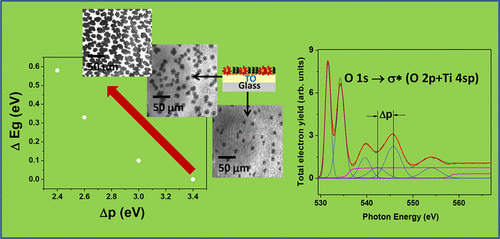当前位置:
X-MOL 学术
›
J. Phys. Chem. C
›
论文详情
Our official English website, www.x-mol.net, welcomes your
feedback! (Note: you will need to create a separate account there.)
Tuning the Band Gap in Titanium Dioxide Thin Films by Surfactant-Mediated Confinement and Patterning of Gold Nanoparticles
The Journal of Physical Chemistry C ( IF 3.3 ) Pub Date : 2017-09-22 00:00:00 , DOI: 10.1021/acs.jpcc.7b04964 Smita Mukherjee 1 , Pradip Sekhar Das 1 , Madhumita Choudhuri 2 , Alokmay Datta 2 , Jiten Ghosh 1 , Biswajit Saha 3 , Konstantin Koshmak 4 , Stefano Nannarone 4 , Anoop Kr. Mukhopadhyay 1
The Journal of Physical Chemistry C ( IF 3.3 ) Pub Date : 2017-09-22 00:00:00 , DOI: 10.1021/acs.jpcc.7b04964 Smita Mukherjee 1 , Pradip Sekhar Das 1 , Madhumita Choudhuri 2 , Alokmay Datta 2 , Jiten Ghosh 1 , Biswajit Saha 3 , Konstantin Koshmak 4 , Stefano Nannarone 4 , Anoop Kr. Mukhopadhyay 1
Affiliation

|
Au nanoparticle (NP)-decorated titanium dioxide (TiO2) thin films (Au-TO), prepared by a unique surfactant-assisted 2D self-assembling technique of Au NP layering onto a titanium dioxide matrix (TO) with molecular-level control, in conjunction with a classic sol–gel route, showed a significant decrease in the optical band gap (ΔEg = ∼0.6 eV) of Au-TO films compared to the conventional sol–gel-prepared pristine counterpart. Strong dependence on surfactant type and deposition temperature of the 2D Au NP layer was observed upon a band gap decrease of the films. Unlike spin-coated Au NP overlayers on TiO2, which resulted in Au NP agglomeration, in this modified inverted Langmuir–Schaefer (MILS) technique, the organic surfactant induced 2D patterned confinement of Au NP layers on TiO2, causing an increase in the active surface area of the Au NP–TiO2 interface. Results of X-ray diffraction and near-edge X-ray absorption fine structure spectroscopy indicated changes in crystal structure as well as in electronic states at the O k absorption edge for Au NP–surfactant patterned films, changes being maximum for films showing a maximum band gap decrease. A temperature evolution of morphology of Au-TO films and their Au NP–surfactant monolayer counterpart at the air–water interface, by ellipsometric imaging and Brewster angle microscopy, respectively, revealed that Au NP patterning was induced by surfactant and varied with the temperature of the Au NP–surfactant monolayer, the band gap decrease being closely associated with a change in the active Au NP–TiO2 surface area. The maximum band gap decrease was observed for Au-TO films having tree- or finger-like 2D Au NP patterns, clearly indicating that an increase in active Au–TiO2 surface area causes enhancement in structural changes and hence a greater band gap decrease of the system. Results demonstrate the potential of the MILS technique of surfactant-aided Au NP-patterned confinement in semiconducting oxides, in band gap engineering of the latter.
中文翻译:

通过表面活性剂介导的金纳米颗粒的限制和构图来调节二氧化钛薄膜中的带隙
通过独特的表面活性剂辅助二维Au-NP自组装技术在分子水平控制下将Au NP层压到二氧化钛基质(TO)上,制备Au纳米颗粒(NP)装饰的二氧化钛(TiO 2)薄膜(Au-TO)与传统的溶胶-凝胶方法相结合,与传统的溶胶-凝胶制备的原始副本相比,Au-TO薄膜的光学带隙(ΔE g =〜0.6 eV)显着降低。在膜的带隙减小时,观察到对2D Au NP层的表面活性剂类型和沉积温度的强烈依赖性。与TiO 2上的旋涂Au NP覆盖层不同,导致Au NP团聚,在这种改进的倒置Langmuir-Schaefer(MILS)技术中,有机表面活性剂在TiO 2上二维形成Au NP层的图案化限制,导致Au NP-TiO 2的有效表面积增加界面。X射线衍射和近边缘X射线吸收精细结构光谱的结果表明,金纳米表面活性剂图案化膜的晶体结构以及Ok吸收边缘的电子态发生了变化,膜的变化最大。带隙减小。分别通过椭偏成像和布儒斯特角显微镜对Au-TO薄膜和其Au NP-表面活性剂单层对应物在空气-水界面处的形貌进行温度演变,结果表明表面活性剂诱导了Au NP图案的形成,并随温度的变化而变化。 Au NP-表面活性剂单层,带隙的减小与活性Au NP-TiO 2的变化密切相关表面积。对于具有树状或手指状2D Au NP图案的Au-TO薄膜,观察到最大带隙减小,清楚地表明,活性Au-TiO 2表面积的增加引起结构变化的增强,因此,更大的带隙减小系统。结果证明了在半导体氧化物的带隙工程中,表面活性剂辅助的金纳米颗粒图案限制在半导体氧化物中的MILS技术的潜力。
更新日期:2017-09-22
中文翻译:

通过表面活性剂介导的金纳米颗粒的限制和构图来调节二氧化钛薄膜中的带隙
通过独特的表面活性剂辅助二维Au-NP自组装技术在分子水平控制下将Au NP层压到二氧化钛基质(TO)上,制备Au纳米颗粒(NP)装饰的二氧化钛(TiO 2)薄膜(Au-TO)与传统的溶胶-凝胶方法相结合,与传统的溶胶-凝胶制备的原始副本相比,Au-TO薄膜的光学带隙(ΔE g =〜0.6 eV)显着降低。在膜的带隙减小时,观察到对2D Au NP层的表面活性剂类型和沉积温度的强烈依赖性。与TiO 2上的旋涂Au NP覆盖层不同,导致Au NP团聚,在这种改进的倒置Langmuir-Schaefer(MILS)技术中,有机表面活性剂在TiO 2上二维形成Au NP层的图案化限制,导致Au NP-TiO 2的有效表面积增加界面。X射线衍射和近边缘X射线吸收精细结构光谱的结果表明,金纳米表面活性剂图案化膜的晶体结构以及Ok吸收边缘的电子态发生了变化,膜的变化最大。带隙减小。分别通过椭偏成像和布儒斯特角显微镜对Au-TO薄膜和其Au NP-表面活性剂单层对应物在空气-水界面处的形貌进行温度演变,结果表明表面活性剂诱导了Au NP图案的形成,并随温度的变化而变化。 Au NP-表面活性剂单层,带隙的减小与活性Au NP-TiO 2的变化密切相关表面积。对于具有树状或手指状2D Au NP图案的Au-TO薄膜,观察到最大带隙减小,清楚地表明,活性Au-TiO 2表面积的增加引起结构变化的增强,因此,更大的带隙减小系统。结果证明了在半导体氧化物的带隙工程中,表面活性剂辅助的金纳米颗粒图案限制在半导体氧化物中的MILS技术的潜力。











































 京公网安备 11010802027423号
京公网安备 11010802027423号